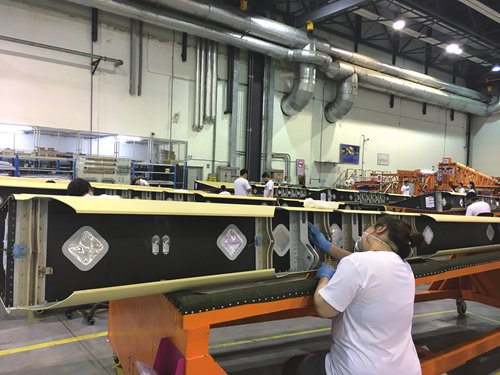
An employee works on the A320 rudder assembly line of the Harbin Hafei Airbus Composite Manufacturing Centre in Harbin, Northeast China's Heilongjiang Province on Tuesday. Photo: Tu Lei/GT
A joint venture (JV) between Airbus and its Chinese partners reached a milestone on Tuesday as it delivered the 1,000th rudder to be used on Airbus A320 aircraft, a development that is being hailed as key step in the Chinese aviation industry's globalization.
Since being established in 2009, the JV - Harbin Hafei Airbus Composite Manufacturing Centre (HMC) in Harbin, Northeast China's Heilongjiang Province - has become the sole global supplier of rudders for the A320 family of aircraft.
After completion, the rudders are usually shipped to Stade, Germany, where they are fixed to the A320 family vertical stabilizers.
The stabilizers are then delivered to assembly lines around the world.
In a ceremony marking the achievement on Tuesday in Harbin, officials from both Airbus and its Chinese partners, including Harbin Aircraft Industry Group Corp and Hafei Aviation Industry Co, hailed the partnership and vowed to expand their cooperation.
"The deliveries have played a solid foundation for the cooperation," Cao Shengli, general manager of AVIC Harbin Aircraft Industry Group Co, said at the ceremony. Cao said that HMC could be a model in supporting the "China Made 2025" strategy and "Belt and Road" initiative.
"The delivery is a milestone for the manufacturing center and for our long-term partnership with the Chinese aviation industry," Airbus Commercial Aircraft China Chief Operating Officer Francois Mery said at the ceremony.
Airbus holds 29 percent of the JV, which aims to manufacture composite materials, parts and components for the A350 XWB program and A320 family aircraft, as part of Airbus' target of making 5 percent of the A350 XWB airframe in China.
Monthly production capacity for the A320 rudder is 48 units. Capacity is six units for the A350XWB per month, the company said.
Experts said that the partnership has proven the progress China's aviation industry has made over the years.
"The delivery of the 1,000th rudder shows that China has achieved an increasingly important position in the global aviation industry's outsourcing, and there are more Chinese elements in the planes after years of development," Lin Zhijie, an independent market watcher, told the Global Times on Tuesday.
Cooperation between Airbus and its Chinese suppliers began in 1985.
In the Airbus 320, Chinese suppliers can produce components including wing leading edges, wing intermediate ribs, cargo door frames and rear passenger doors. In the Airbus 350XWB, components including belly-fairing panels, rudders and elevators can be designed and manufactured in China as well.
Airbus said that the total value of its industrial cooperation with the Chinese aviation industry reached $140 million in 2009 and jumped to about $500 million in 2015.
Airbus is not alone.
Boeing Co said that its activity in China contributes $800 million to $1 billion annually in direct support of China's economy, including procurement from the extensive supply base, joint venture revenues, operations, training, and research and development investment.
Boeing has worked with more than 35 major Chinese companies as direct contractors in production and also with hundreds of Chinese subcontractors.
China builds horizontal stabilizers, vertical fins, the aft tail section, doors, wing panels, wire harnesses and other parts on the Next-Generation 737.
China also produces the rudder for the 737 MAX, a more fuel-efficient version of the best-selling 737 Classic. China contributes trailing edge wing ribs, horizontal stabilizers, vertical fins, ailerons, spoilers and inboard flaps for the 747-8.
In addition, China has an important role on the 787 building the rudder, wing-to-body fairing panels, leading edges and panels for the vertical fin, and other composite parts.
However, Lin said that the Chinese aviation industry should not just be limited to the role of a supplier in global aviation manufacturing.
The main reason that manufacturers outsource components is not merely technological ability, it is mainly due to cost savings, according to Lin.
It is important for the suppliers to get involved in the production chains, but it is more important to have the ability to independently develop the key parts such as engines. It is positive for domestic aircraft such as the C919, and it is also good for the improvement of the country's aviation industry, Lin added.

